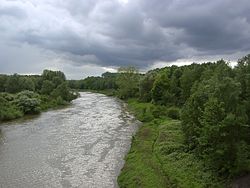Lippe (river)
| Lippe | |
|---|---|
 The Lippe in Lünen | |
 | |
| Location | |
| Country | Germany |
| State | North Rhine-Westphalia |
| Physical characteristics | |
| Source | |
| • location | Eastern Westphalia |
| • elevation | ±140 m (460 ft) |
| Mouth | |
• location | Rhine |
• coordinates | 51°39′3″N 6°36′15″E / 51.65083°N 6.60417°E |
| Length | 220.3 km (136.9 mi) [1] |
| Basin size | 4,889.9 km2 (1,888.0 sq mi) [1] |
| Basin features | |
| Progression | Rhine→ North Sea |
| Tributaries | |
| • left | Pader, Alme, Ahse, Seseke |
| • right | Glenne, Stever |
The Lippe (German pronunciation: [ˈlɪpə]) is a river in North Rhine-Westphalia, Germany. It is a right tributary of the Rhine and 220.3 km (136.9 mi) in length with an elevation difference of 125 metres and a catchment area of 4.890 km². The source is located at the edge of the
Description and history
The river Lippe has been used as an infrastructure in Roman times. For the Romans the river (named Lupia)
Today, the river appears as a two-tier water course: Upstream, eastward of the city of Hamm, the catchment is more rural. Downstream of Hamm settlements and industrial impacts characterize the situation. Though the Lippe was partly navigable from 1820 on it was not sufficient for the transport of industrial goods.
Historically, the preconditions for a change of the landscape started with the construction of the
Until the 1970s water pollution played no important role in the public debate but the environmental policy changed over the decades. Environmental standards on national level and especially from the EU have been leading to enormous efforts to improve the natural standards and today a couple of positive developments can be stated, like new FFH (Flora Fauna Habitat) sites [5] and governmental initiatives around the WFD (Water Framework Directive).[6][7]
Tributaries
The main tributaries of the Lippe are (from source to mouth):
- Left: Steinbeke, Beke, Pader, Alme, Heder, Brandenbaumer Bach, Gieseler, Trotzbach, Ahse, Seseke, Sickingmühlenbach
- Right: Thunebach, Thune, Glenne, Baagebach, Quabbe, Geinegge, Stever
Cities and towns
References
- ^ a b Hydrographic Directory of the NRW State Office for Nature, the Environment and Consumer Protection (Gewässerverzeichnis des Landesamtes für Natur, Umwelt und Verbraucherschutz NRW 2010) (xls; 4.67 MB)
- ^ Salmon, Nicholas (March 13, 1796). "Stemmata Latinitatis; or, An etymological Latin dictionary" – via Google Books.
- ^ "Römerlager an der Lippe". Google My Maps.
- ^ "History of the Lippeverband". Archived from the original on January 27, 2016.
- ^ EU LIFE project Lippeauen
- ^ "Umweltministerium NRW: Detailseite Broschüren". www.umwelt.nrw.de.
- ^ "FLUSSGEBIETE NRW". FLUSSGEBIETE NRW.
External links
- Lippe – Roman settlements along the Lippe.
- Life Project Lippeaue – One of the Lippeaue renaturation projects

